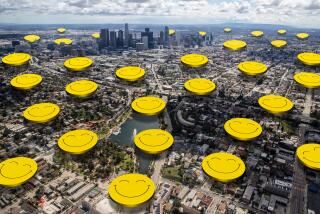Mural History of the City Flows From Tip of Their Brushes
Sixteen-year-old Edgar Castaneda dipped his brush into freshly mixed blue paint and meticulously added his strokes to the mural history of Los Angeles.
Castaneda and three other young men were putting the final touches recently on an 18-foot-high mural in Boyle Heights under the direction of veteran Eastside muralist George Yepes.
The mural, “Mujer del Este de Los Angeles/Lady of the Eastside,” depicts a veiled Latina holding the flags of more than 100 countries. The Mexican flag is draped at the woman’s heart and the U.S. flag is below that.
The work expresses an idealistic world where “all countries and people are united,” said Castaneda, a student at Boyle Heights Continuation High School.
The youth said he is proud of the mural, one of 15 being produced this year by experienced artists and youth assistants throughout the city of Los Angeles.
Yepes, the mural’s creator, said the program is right at home in Los Angeles, which is known as “the mural capital of the world” because of the more than 1,000 murals that adorn walls throughout the county.
The mural program, known as “Neighborhood Pride: Great Walls Unlimited,” was commissioned by Mayor Tom Bradley’s office in 1988. It is designed to foster neighborhood pride and reflect Los Angeles’ multiethnic diversity.
“The murals mirror the flavor of their communities,” said Joe B. Rodriguez, executive director of Social and Public Art Resource Center, the organization designated by the city to oversee the production of the murals. “They are telling people of all races and nationalities to hold their heads up high.”
Last year the program produced nine murals and 15 are being produced this year with a budget of $405,000. Rodriguez said 97 artists competed for this year’s projects; the 15 artists chosen were paid $7,000 each and were provided with paint and equipment.
The title for the “Lady of the Eastside” was inspired by Our Lady of the Angels from whom Los Angeles took its name, said Yepes, 34. The model for the mural, he said, was Guadalupe Ontiveros, 32, a student at East Los Angeles College who is originally from Mexico.
His painting, Yepes added, represents a community that has matured greatly and become multi-ethnic. After painting murals for 15 years, Yepes has dedicated the last two years to gallery painting, but he said “The Lady of the Eastside” signifies his return to street art.
“I want to shift my emphasis back to the murals,” he said. “They are what I like to do. I enjoy painting large-scale projects and having more people see my art.”
The murals’ popularity in Los Angeles, Yepes said, is rooted in the large Latino population with a long tradition in mural painting. This cultural fascination with murals is also responsible for eight of the 15 muralists this year being Latinos, he said.
“Our people have great admiration for murals. It is a highly respected art form in many Latin American countries,” said Yepes, who is of Mexican descent.
The majority of U.S. residents, however, place very little value on muralists, said Willie Herron, who, with funding from SPARC, is restoring “La Doliente de Hidalgo” (“The Struggle of Hidalgo”), an Eastside mural at 4301 City Terrace Drive. The mural, which he completed in 1976, depicts Father Miguel Hidalgo, whose cry for freedom triggered the start of Mexico’s war of Independence.
“The young cover them (murals) with graffiti and the old take them for granted thinking they’re advertisements,” said Herron, who in the last 10 years has had four of his murals whitewashed. “Muralists have to accept that their art many times is temporary. That’s the harsh reality.”
Castaneda, who lives at the Aliso-Pico housing project across the street from “Lady of the Eastside,” hopes that the mural he’s put so much time into will be an exception.
He said his parents are delighted with his work on the mural, which is at 418 S. Pecan St. and is visible from the northbound Hollywood Freeway (U.S. 101) near 4th Street. “They like that I’m doing this,” said Castaneda, who sported a crew-cut haircut and wore a cigarette over his right ear. “I’m making money and staying out of trouble.”
More to Read
Sign up for Essential California
The most important California stories and recommendations in your inbox every morning.
You may occasionally receive promotional content from the Los Angeles Times.










